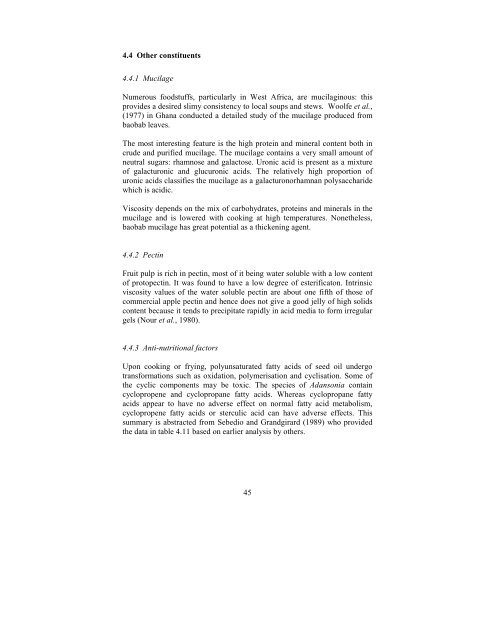Baobab Monograph.pdf - Crops for the Future
Baobab Monograph.pdf - Crops for the Future
Baobab Monograph.pdf - Crops for the Future
Create successful ePaper yourself
Turn your PDF publications into a flip-book with our unique Google optimized e-Paper software.
4.4 O<strong>the</strong>r constituents<br />
4.4.1 Mucilage<br />
Numerous foodstuffs, particularly in West Africa, are mucilaginous: this<br />
provides a desired slimy consistency to local soups and stews. Woolfe et al.,<br />
(1977) in Ghana conducted a detailed study of <strong>the</strong> mucilage produced from<br />
baobab leaves.<br />
The most interesting feature is <strong>the</strong> high protein and mineral content both in<br />
crude and purified mucilage. The mucilage contains a very small amount of<br />
neutral sugars: rhamnose and galactose. Uronic acid is present as a mixture<br />
of galacturonic and glucuronic acids. The relatively high proportion of<br />
uronic acids classifies <strong>the</strong> mucilage as a galacturonorhamnan polysaccharide<br />
which is acidic.<br />
Viscosity depends on <strong>the</strong> mix of carbohydrates, proteins and minerals in <strong>the</strong><br />
mucilage and is lowered with cooking at high temperatures. None<strong>the</strong>less,<br />
baobab mucilage has great potential as a thickening agent.<br />
4.4.2 Pectin<br />
Fruit pulp is rich in pectin, most of it being water soluble with a low content<br />
of protopectin. It was found to have a low degree of esterificaton. Intrinsic<br />
viscosity values of <strong>the</strong> water soluble pectin are about one fifth of those of<br />
commercial apple pectin and hence does not give a good jelly of high solids<br />
content because it tends to precipitate rapidly in acid media to <strong>for</strong>m irregular<br />
gels (Nour et al., 1980).<br />
4.4.3 Anti-nutritional factors<br />
Upon cooking or frying, polyunsaturated fatty acids of seed oil undergo<br />
trans<strong>for</strong>mations such as oxidation, polymerisation and cyclisation. Some of<br />
<strong>the</strong> cyclic components may be toxic. The species of Adansonia contain<br />
cyclopropene and cyclopropane fatty acids. Whereas cyclopropane fatty<br />
acids appear to have no adverse effect on normal fatty acid metabolism,<br />
cyclopropene fatty acids or sterculic acid can have adverse effects. This<br />
summary is abstracted from Sebedio and Grandgirard (1989) who provided<br />
<strong>the</strong> data in table 4.11 based on earlier analysis by o<strong>the</strong>rs.<br />
45

















